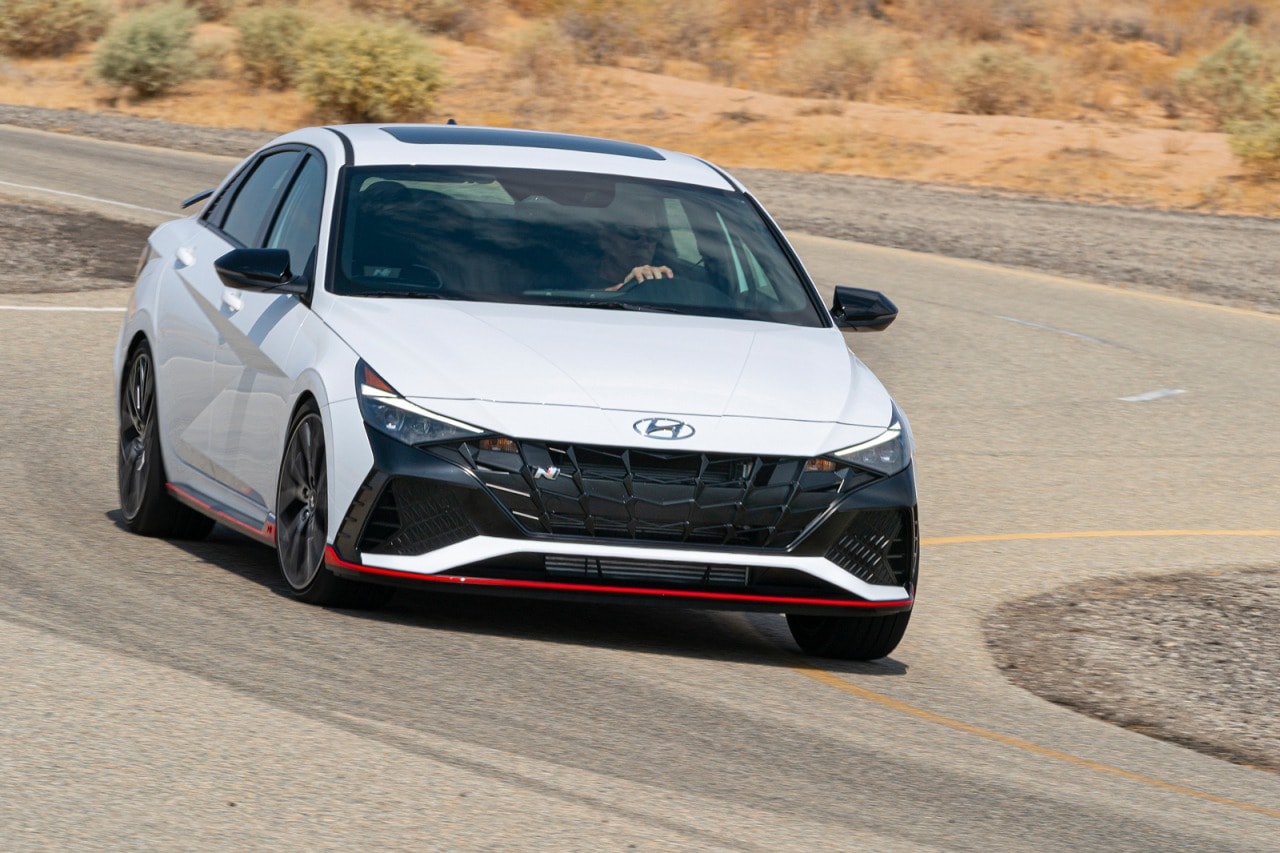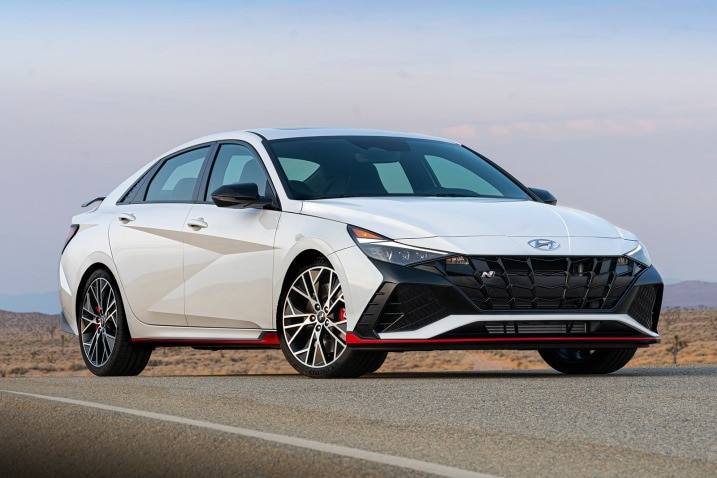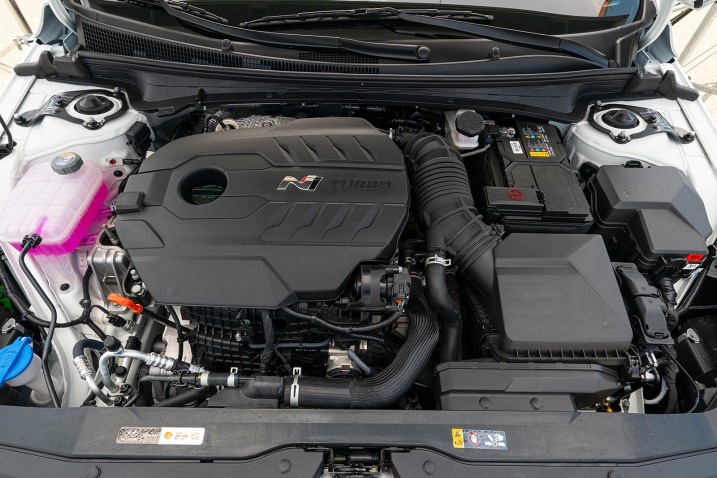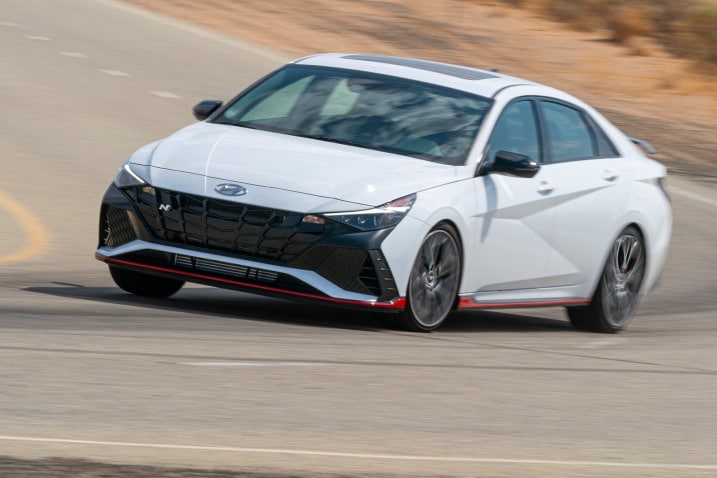- The Elantra N boasts significant chassis improvements.
- Hyundai hasn't skimped on the features.
- The Elantra N is an absolute hoot to drive.
The Elantra N Throws Down the Gauntlet for the Affordable Sport Sedan Crown
Good power, good handling, good times
Well mannered and well rounded, the recently redesigned Hyundai Elantra makes a strong case for itself in the small sedan class. Now for 2022 Hyundai is expanding the Elantra's appeal with the introduction of the performance-tuned 2022 Elantra N.
Overseen by performance engineering guru Albert Biermann, the N division got to work modifying, reengineering and generally adding a whole lot of real-world performance to its sensible sedan. The result? Well, let's just say that another manufacturer might need to relinquish the whole "four-door sports car" thing to Hyundai. Oh, and it comes with a manual transmission too.
So what makes this an N?
Where to begin? The list of modifications that Hyundai's N division has made to the Elantra would put a CVS receipt to shame. But we'll give it a shot. On the chassis side, the Elantra N has added reinforcement in the form of modified underbody mounting points, an exhaust tunnel brace, a new strut ring (adding reinforcement at the top of the strut tower) and added a triangulated rear bar just behind the back seats for extra stiffening; the N is 29% stiffer in twisting rigidity than the standard Elantra. And in case you're wondering, the back seats still fold down even with the new bracing in place. You do lose some flexibility in storing longer items, but we do appreciate the effort.
Suspension-wise, aside from the electronically adjustable shocks, various bushings have been reengineered to increase stiffness without sacrificing ride quality. Even the axles have been redesigned. Technology from Hyundai's WRC car has been brought over in the form of the integrated drive axle. Not only is the axle bigger, but the axle and drive hub assembly have been combined to make the assembly stronger as well as lighter. This benefits both ride quality and handling feel. We also learned that Hyundai's touring car team uses a fair number of off-the-shelf suspension parts from the Elantra N in its race cars, even when they have the option to fabricate those same parts. To us, that speaks volumes to their durability and strength.
Yeah, OK, but what about horsepower?
The Elantra gets a modified version of the turbocharged 2.0-liter four-cylinder used for the Veloster N hatchback. The Elantra N's version gets a larger turbocharger and a fresh tune to reduce turbo lag and widen the powerband. Power is 276 hp and 289 lb-ft with the nifty overboost button pushing peak power, briefly, to 286 hp. Torque is up 29 lb-ft from the Veloster N powerplant, with peak torque available from 2,000 rpm to just under 5,000 rpm.
And if you're wondering about torque steer, yes, the Elantra N does have that. If you're not familiar with torque steer, it's the influence the engine's power (torque, in this case) has over a vehicle's steering. It happens under hard acceleration and drivers will feel the steering wheel tugging in one direction or the other. It's a trait common to high-horsepower front-wheel-drive cars.
And while many manufacturers have struggled with eliminating this trait, Hyundai has embraced it. The aforementioned engineering mastermind, Mr. Biermann, sees torque steer as a necessary thing in a performance-oriented front-wheel-drive car. And rather than spend countless development dollars and inevitably add weight and complexity to the Elantra N's front suspension to find a partial solution, his team has simply managed and tuned the torque steer to be a form of communication the front wheels have with the driver.
In practice, the Elantra N's steering wheel certainly does wriggle around in your hands, but it's never violent and actually becomes a bit fun to feel the car fighting for traction while still maintaining its line out of a corner. It's a different approach, but we think it works very well in practice.
Can I get the Elantra N with a manual transmission?
Yep. The Elantra N comes with your choice of an eight-speed dual-clutch automatic (DCT) or a six-speed manual transmission. While the DCT largely carries over from the Veloster N, the manual transmission features a reinforced case, a new dual-mass flywheel, heavy-duty bearings, and additional reinforcements for the gears and synchros. The six-speed also features automated rev matching, so you can make super-smooth downshifts without having to use the tricky-to-learn heel-and-toe shifting technique.
The DCT's behavior can be tailored to suit, and those settings can be found in the Elantra's impressive N mode menu. Even in its standard setting, the DCT offers up smooth shifts and responds quickly to any requests made through the paddles. But when you select the N Power Shift setting, shifts become more forceful and replicate a more abrupt shift from a manual transmission. It's not our favorite, even if Hyundai says it makes for slightly faster acceleration.
Does the N stand for "No Features"?
Absolutely not. The N most closely matches the top-of-the-line Limited trim level and features 10.25-inch digital displays for both the instrument panel and infotainment touchscreens. There's wireless charging, smartphone connectivity, dual-zone climate control and an upgraded Bose audio system. A sunroof is available, but only if you opt for the DCT. Hyundai figures drivers who wanted the involvement of the six-speed manual might want the lower center of gravity afforded by not having the sunroof.
The N gets its own unique sport seats that sit about 10 mm (about 0.4 inch) lower than the standard seats. Even taller drivers had no issue with headroom (even when wearing a helmet) and the seats offered excellent support during our all-too-brief time on track. These heated seats are wrapped in leather and suede and feature a lighted N logo, because why not? A specific N steering wheel and shift knob are leather-wrapped as well.
Advanced driver aids are also included and feature automatic emergency braking, blind-spot monitoring with rear cross-traffic alert, lane keeping assist, driver attention warning and safe exit warning. Hyundai's digital key is also standard, as are keyless entry and push-button start.
So will it dust off a sports car?
We're not going to go quite that far, but Hyundai does estimate a 0-60 mph time of 5.0 seconds for the DCT-equipped car when you use the built-in launch control. On the road, this motor makes excellent power, especially in its midrange, and features fairly quick throttle response in its normal drive mode. The DCT is nearly seamless, and the six-speed manual is just so easy thanks to an intuitive clutch takeup and a sportive, well-weighted shift throw.
Pressing the blue N button on the right side of the steering wheel activates the more aggressive N drive mode and opens up an array of options, allowing you to customize things such as the suspension tuning, behavior of the limited-slip differential, the transmission, stability control, steering weight, and even the exhaust noise (it'll snap, crackle and pop for days) and interior engine sound. Yes, there's a sound generator and, yes, we know not everyone likes them.
Hyundai has named a few of the cars it considers as the Elantra N's competition. The new Subaru WRX is at the top of the list, but the Honda Civic Type R is up there as well. The redesigned version will certainly give the Elantra N a run for its money but will likely cost more and likely look a bit more, shall we say, intense than the Elantra. Other rivals include the Jetta GLI and the evergreen Volkswagen GTI.
I'm guessing it handles well, too?
Even after our brief drive on both road and racetrack, we think the Elantra N is one of the best sport sedans you can buy for a reasonable amount of money. The steering is quick, and the car turns willingly and cleanly into a bend. Even over substantial bumps, the Elantra N stays composed and on track, giving you the confidence to drive it into a corner a little harder than you might do in, say, the somewhat more skittish Veloster N.
That impressive handling is also due to the N's standard Michelin Pilot Sport 4 S tires. Mounted on 19-by-8-inch wheels, these tires have become the go-to for any serious sport sedan. But behind those 19-inch wheels lurk 14.2-inch front and 12.4-inch rear rotors. These are roughly 2 inches bigger than the brakes on the standard Elantra and feature improved cooling and even heat shielding for the brake lines in the engine bay. Another nifty feature of these brakes is something Hyundai calls the prefill function. When the accelerator is released, in anticipation of hard braking, the braking system maximizes hydraulic pressure for immediate braking response. We don't know how well they'd hold out over the course of a track day, but down a pretty fun little back road, we experienced no fade and plenty of confidence.
Edmunds says
Just when you worried the Veloster was going to be the only way to access Hyundai's impressive N division in the U.S., out storms the Elantra N. Packed with engineering expertise gained from its rally and touring car racing experience, the Elantra N offers satisfying acceleration, grin-inducing handling along with the comfort and value we've come to expect from the regular Elantra. Hyundai hasn't yet released official pricing, but we'd expect the N to come in right around $35,000. Stay with Edmunds for up-to-date pricing information and a full review when the Elantra N goes on sale later this year. Oh, and did we mention it comes with a six-speed manual?








 by
by 
